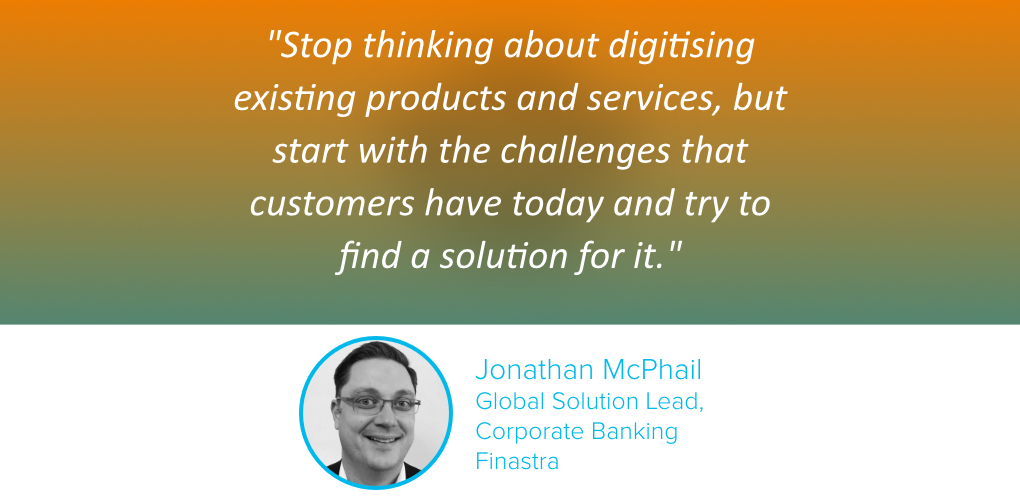
Insights & Opinions
Bridging The Gap: Open Finance, an Opportunity For Every Bank
Tue, 08 Dec 2020

On December 3rd, The Banking Scene collaborated with Finastra to find out what open finance means and how it will impact financial services. Together with Jonathan McPhail, Global Solution Lead, Corporate Banking, we investigated the opportunities of open finance and what the best scenarios are for banks going forward.
From open banking to open finance
Open banking is one of the most discussed agenda items of the last couple of years in financial services. With median spending in Europe between €50 million and €100 million, banks are betting big on it, and finding a return on investment (ROI) is challenging.
With open finance, the industry is looking ahead, going the extra mile to find the required ROI on open banking investments. Open finance uses the same mechanics like open banking: publicly available APIs, authentication, secure connectivity in a consented way etc.… and applies them to a much broader set of products and services, not just transaction information, and payment initiation like it is demanded by the regulator, according to Jonathan.
It covers both finance being open and available for all with a focus on more inclusion and the development of ecosystems, as we can see in developed countries. Since both are working on the same rails, standardisation of open banking will have a direct positive impact on both the uptake and cost reductions of open finance.
Now is the time to invest in open finance, to test the possibilities and to grow your experience. Every bank must prepare for a future where finance is embedded in everything, and everything is embedded in finance.
The opportunities for open finance
Amongst the 1.000 Finastra customers globally, Jonathan witnessed 2 main drivers that will improve the ROI of open banking through open finance:
- it allows scaling sales and onboarding new customers
- it provides new means to enhance the customer experience
The ability to scale and the improvements in customer experience go hand in hand in the context of open finance. Jonathan: “Think about how you onboard customers, how you interact with them and what your channels are: open finance can help with all of these. This goes with technology development, but also with the sales approach. You can take the positives of a platform approach and create networks and try to scale your access to the market.”
Instead of thinking in terms of banks channels, open finance forces organisations to find out where the customer is, and to serve that customer where it pleases him, not the other way around. You create a network of affiliate channels, and you grow your sales channels, and leads, exponentially.
What’s more, open also facilitates easier partnerships that support a bank in your day-to-day management. Jonathan: “KYC is one of the biggest pain points of most of the financial institutions worldwide. There are very bright fintechs that have great tools available to overcome this. Through open finance, it is a lot easier to connect to these fintechs and to overcome the KYC challenge through a partnership.”

What is important is that banks stop thinking about digitising existing products and services, but start with the challenges that customers have today and try to find a solution for it.
If SME banking is the new gold…
In May 2020, we learned from Brad van Leeuwen that COVID-19 will trigger a new generation of entrepreneurs to rise up. Many markets paused, resulting in liquidity problems. Once COVID-19 is back under control, demand will go up again, with many suppliers that will not have survived.
New businesses, with new customer expectations, will compensate for this. These people demand seamless financial services, and many are willing to give up (some of their) privacy to facilitate this at a low cost.
Jonathan: “SMEs are underserved, they need financial services, and they want these products at a low price. Perhaps the additional data can be the currency to make sure as a bank, you are capable of providing these products at a lower cost.”
SMEs require more administration, and they are more complex to manage. As a consequence, digitisation of financial services did not follow at the same pace for this segment as it did in retail banking. However, improvements in automation and technology, in general, provide all the toolings to overcome this.
Banks that invest in automation and digital customer delight will reduce the cost per business while earning more per business customer compared to retail banking. Entering this market can help banks grow fee income to compensate for the loss of profits because of low-interest rates in the market.
… open finance is the sieve to claim it…
SMEs are demanding more complex products than they may have in the past, Jonathan explained. It gets close to corporate offerings, but obviously in much bigger volumes and a much more efficient process. It makes this segment less appealing for corporate banks and, at first sight, too complex for retail banks.
Jonathan: “SME may be at that point where we need to think what these people need. High-level, we know what they need. That is access to funding, getting paid when they sold something and managing their accounts. It is about helping them to stop thinking about money.”
Once you detected their challenges, a network of partners and sales channels, provided by open finance, will give a bank the right tooling to solve them, instead of incremental improvements of existing products and services. The other way around, having an SME to connect all the accounts from different platforms, will help that bank to get a better, consolidated overview to personalise the offerings to them.
There is a reason, for example, why banks build marketplaces for their customers. Or why Stripe (not a bank) announced last week to provide banking services. The marketplace provider where SMEs sell their products has access to what they are selling, who they are selling it to, how they are selling.
Or look at payroll services, which provides access to the number of employees, their retention rate, the time they may need short-term credit to pay those loans, etcetera.
…and small and midsized banks are uniquely positioned to dig the new gold
Jonathan believes that open finance is changing the perception of SMEs. He believes that retail banks, especially the smaller ones that invest in personal relationships, have the required assets to dig the new gold called SMEs. Dealing with a business and the owner will become much more intertwined.
Take the lending process, for example. The insights on the individual can lift the credit score of the business, which a corporate bank cannot provide, as they lack the personal relationship.
An additional advantage of open finance is that it allows integrating business product solutions from third-parties, to test these products for market fit before in-house production.
Open finance helps banks to transform their customers into new sales representatives. Look for collaborative win-wins with your customers, instead of being one of many providers that bid on price. Instead of thinking out of the box, banks need to get out of their box.
Small and mid-sized banks may have a head start compared to many big banks. They tend to have a horizontal organisation structure with short decision processes. On top of that, they acknowledged that adopting external new technologies for automation and a better customer experience is the best approach to maintain their competitive edge.
3 tips for bridging the gap with the big players
Of course, as I said in the beginning. Big banks have big budgets, they are the ones that plan to spend €100 million and more in open banking and open finance. So what should smaller bank with lower budgets do to guard against this?
The first advice of Jonathan is to choose investments wisely: “As a financial institution, you have to be very clear on what your competitive edge is. A lot of banks set up in a very specific market with a specific focus. It is really about leveraging that focus in a way that can’t be easily replicated, either by new players, by other similar players or Bigtech.”
The second advice is to “Have sympathy with your customers and understand what it is that they are trying to solve. Stand next to them in the customer journey and help them overcome the challenges that they have by putting the standard solutions together in the right way to solve that.
Get in front of them and remain in front of them for as many of the tasks that they undertake during the day to stay relevant and be able to position other products.”
The third advice is to work with partners. Jonathan: “The banks that we have seen being successful thus far are those who are humble in their approach and that listen to innovation coming from outside. Those that keep trying to do everything themselves with internal developments are the ones we have seen who haven’t progressed as quickly.”
The poll during the session showed that 75% of the audience believed that small and midsized banks will fall back more on outsourcing of some activities to bridge the gap with the big banks to seize the opportunities of open banking.
Incorporating partners within an overall offering is the best way to accelerate the path to open finance.